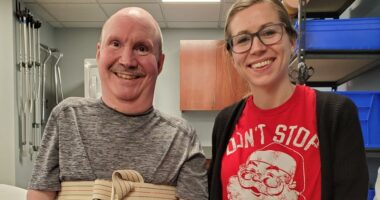‘We are lucky and unlucky,’ SMA caregivers say of new treatments
Study finds SMA therapies offer hope, but come with challenges

For caregivers of children with spinal muscular atrophy (SMA), the availability of new disease-modifying treatments has offered hope — but difficulties in accessing these therapies and uncertainty about their long-term effectiveness also have fostered frustration and anxiety.
That’s according to a new qualitative study, done in Canada, that aimed to get a better understanding of the experiences of parents who have children diagnosed with the rare genetic disorder.
“The caregiver experience with SMA has been transformed by the advent of disease-modifying therapies,” the researchers wrote.
“Many caregivers described going to great lengths to access therapies, highlighting issues related to justice, such as equity and access,” the team wrote, adding that their findings “highlight the need for effective and equitable delivery of orphan drugs to allow timely access to emerging, costly, life-sustaining therapies.”
The study, “Understanding caregiver experiences with disease-modifying therapies for spinal muscular atrophy: a qualitative study,” was published in Archives of Disease in Childhood. The work was funded by Cure SMA Canada.
3 new SMA treatments developed in last decade
For most of human history, SMA was the most common genetic cause of death among infants. But in the past decade, three new therapies have become available: the one-time gene therapy Zolgensma (onasemnogene abeparvovec-xioi), the daily oral therapy Evrysdi (risdiplam), and Spinraza (nusinersen), which is given by injection via the spine every few months.
While none of these therapies can reverse damage caused by SMA, they all can effectively slow or even stop the disease’s progression — as such, it’s broadly recommended that people with SMA should start on these treatments as early as is possible. These medications have revolutionized living with SMA for many patients, and impacted the experiences of their caregivers as well.
Now, scientists in Toronto sought qualitative data to go along with quantitative information about the impact of these new SMA treatments. To that end, the team conducted interviews at The Hospital for Sick Children with 15 caregivers of children with SMA, with an aim to better understand their experiences in accessing treatments as they were first becoming available.
“Our primary aim was to explore the patient and family experience accessing and receiving disease-modifying therapies for SMA during a unique window of opportunity in the early disease-modifying therapy era,” the researchers wrote.
The caregivers included 11 mothers and four fathers of children with SMA. Most of them were married/partnered and had received a college education.
Interviews with caregivers reveal challenges with SMA treatments
From the interviews, which lasted about an hour on average, the researchers identified a few overarching themes. One major theme was difficulty in accessing therapies and frustration with inequities in access.
Some of these inequities came down to the geographical locations where the therapies are or are not approved. One caregiver moved patient and family from Canada to the U.S. to access Zolgensma after it had been approved in the U.S. but before it became available in Canada. Several of the caregivers had moved with their families to Canada to access therapies that were approved there, but not yet available in their countries of origin.
“The willingness of family caregivers to sacrifice for the wellbeing of their children was unwavering despite financial, social, psychological and physical challenges,” the researchers wrote, adding that, “in the most extreme cases, family caregivers gave up their livelihoods by relocating to different countries to access active interventions for their children with SMA.”
Even when therapies were approved, however, caregivers frequently encountered obstacles in actually obtaining them. Among the challenges were the high cost of these treatments and a lack of clinical infrastructure to administer them.
“Systemic inefficiencies including delayed diagnosis, setbacks in obtaining drug and financial coverage approvals, and restricted health system capacity were all highlighted as barriers that delayed administration of disease-modifying therapies,” the researchers wrote.
The researchers noted that access to these therapies in Canada has been greatly improved since these three treatments became covered by government-run health insurance programs. Nonetheless, “restrictive access criteria excluded some children from specific therapies and were a source of frustration for many family caregivers,” the scientists said.
Access, long-term benefits remain key concerns with SMA treatments
Difficulty in accessing medication was often a source of extreme stress for families, especially given the importance of starting treatment as early as possible. For most caregivers, obtaining treatment was viewed as not really a choice, when the alternative was letting their child’s SMA worsen. Due to issues with availability and funding, families often didn’t have any choice about which of the treatments they were able to get.
Despite the difficulties and frustrations with access, caregivers broadly expressed hope that treatment would benefit their children.
“We are lucky and unlucky. We are lucky there is a treatment. Unlucky because we are in the first line,” one caregiver said.
The caregivers’ expectations differed depending on where their child was at in the SMA journey. For caregivers of children who had already experienced a lot of disease progression, stabilizing the decline and small improvements in motor function were seen as hopeful goals. For children who were diagnosed very early and started treatment before developing notable symptoms, caregivers expressed hope that their child might have more of a “normal or independent” life, as one parent said.
We are lucky and unlucky. We are lucky there is a treatment. Unlucky because we are in the first line.
While getting these SMA treatments offered hope, they also brought their own uncertainties and worries. Because all three available therapies were developed very recently, there are no data on their effectiveness over the long term, and some caregivers worried about what would happen if a treatment stopped working.
Several caregivers also expressed concerns about continuing to access and afford these therapies in the future.
“The most prominent concern for caregivers was consistent and predictable access to disease-modifying therapies in the face of a life-limiting illness,” the researchers wrote. They stressed a need for healthcare systems to continue to work to ensure that these and other life-saving therapies are accessible for the people who need them.






